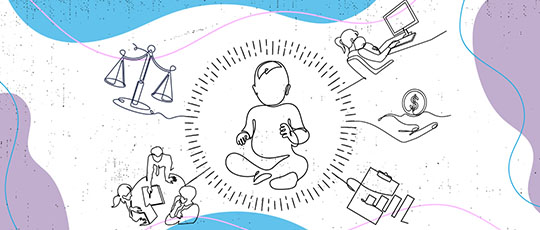- SECURE 2.0 opens doors. Starting in 2024, as much as 3% of an employee’s paycheck can be automatically placed in an emergency savings account.
- Savings are a major financial concern. One recent survey of 1,000 employees found that contributing to a savings account is one of their biggest financial concerns.
- Emergency savings accounts can offer relief. According to one expert, emergency savings can support the short-term needs and stresses workers face today, which in turn helps them meet long-term goals and boosts their overall sense of financial security.
Contributing to a savings account is one of the biggest financial worries for employees, according to a recent survey of 1,000 U.S.-based workers from career website Zety.
To help alleviate those concerns, more employers are considering adding an emergency savings account (ESA) as a new benefit to support and retain talent. ESAs can be used on unexpected expenses, such as medical bills and car repairs.
And, thanks to the SECURE 2.0 Act, retirement plans may now offer linked ESAs that permit non-highly compensated employees to make Roth (after-tax) contributions to a savings account within the retirement plan. Starting in 2024, as much as 3% of an employee’s paycheck can be automatically placed in an ESA. Employees can deposit up to $2,500 total, and they can withdraw the money up to four times a year with no fees, CNBC reported.
The Benefits of Offering an ESA
Emergency savings programs have been a growing benefit trend since before the pandemic, with recent economic challenges accelerating the need, said Shannon Hanko, director of financial resilience at WTW.
According to WTW’s 2024 Well-Being Diagnostic Survey, nearly 40% of employers now offer and promote solutions to improve employee access to emergency funds, with another 20% considering adding the benefit in the near future.
Hanko noted financial distress can have a significant impact on an employee’s performance and engagement, as well as their mental and physical health. For example, WTW’s 2024 Global Benefits Attitudes Survey, which included 10,000 U.S. employees working at medium and large private-sector employers, found workers with financial problems:
- Are two times more likely to miss work
- Are two times more likely to be searching for a new job
- Are over three times more likely to be in poor health
- Experience three and a half times higher levels of anxiety or depression.
Employees also desire employer-provided support, Hanko said. According to WTW’s well-being survey, two-thirds of employees rank financial well-being as the area where they would like their employer to help them the most over the next three years. Within financial well-being support, “Provide access to money in an emergency” ranked third among most important potential offerings, after “Help me grow my savings and wealth” and “Help me to get the most out of benefits.”
Addressing employees’ financial worries requires a strategic, consistent and employee-centric approach that encompasses both day-to-day and long-term needs, said Hanko.
“Emergency savings programs are a key financial tool, allowing employees more options to save — and, in some cases, the opportunity for additional funds — for life’s unexpected expenses and financial hardships,” she said.
Long-Term Effects in the Workplace
Amy Vaillancourt, senior vice president for workplace product development and architecture at Voya Financial, said the need for emergency savings has been on the rise in recent years.
In fact, several large U.S. employers have already implemented an emergency savings program for employees:
- Delta Air Lines allows employees to earn up to $1,000 to fund their rainy-day accounts through a combination of employees completing financial wellness actions and the company matching employee contributions.
- Starbucks introduced its “My Starbucks Savings” to help employees save for the unexpected, with the company contributing $25 and $50 credits at key milestones up to $250.
- Unum Group allows 401(k)-eligible employees to contribute any amount up to $10,000 to an after-tax fund that has the same investment options as the company’s 401(k) program, allowing the potential to grow faster than a traditional savings account.
“Unplanned expenses are common for all age groups and economic levels, so not having adequate emergency savings to cover unexpected expenses can be a major contributor to financial stress,” Vaillancourt said.
Read: Helping Employees Secure Their Retirement Future
Vaillancourt also noted financial stress can put an employee’s retirement at risk because many people turn to their retirement plans to meet short-term financial needs. According to Voya retirement plan participant data, employees without adequate emergency savings are:
- 30% more likely to decrease their 401(k) contribution rates
- 13 times more likely to take a hardship withdrawal
- Three times more likely to take a loan from their retirement plans.
“This is where an emergency savings fund can support the short-term needs workers face today, which then can help them meet their long-term goals and provide a greater feeling of financial security,” Vaillancourt said. “More employers offer these solutions to help broaden their overall workplace benefits savings packages and aim to meet the unique needs of their employees with in-plan and out-of-plan solutions.”
Vaillancourt surmised that, with the help of SECURE 2.0, more employers will be interested in pursuing these solutions for their workforces.
“While there’s no one-size-fits-all solution, it comes down to prioritization and customization within an employer’s broader benefits package and offerings,” she said.
As economic uncertainties continue to impact the workforce, the need for robust employer support in financial and retirement planning becomes more apparent, WTW’s Hanko added.
“By focusing on aligning their strategies with employee needs, employers can enhance financial security and confidence among their workforce, paving the way for more secure, satisfied outcomes,” she said.
Editor’s Note: Additional Content
For more information and resources related to this article, see the pages below, which offer quick access to all WorldatWork content on these topics:




